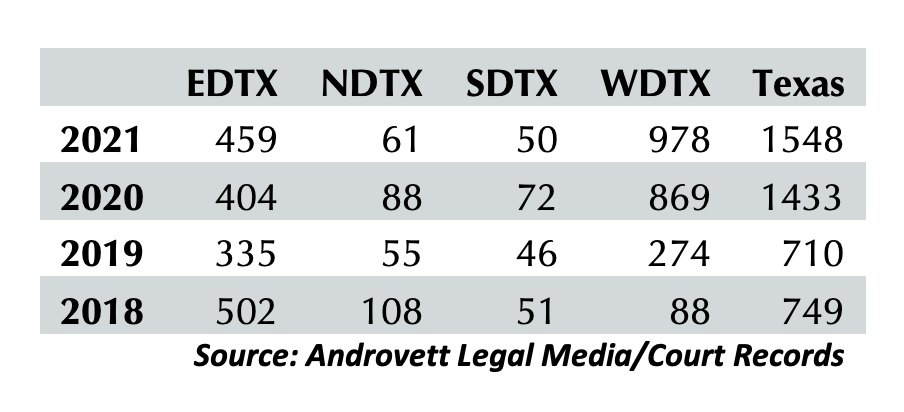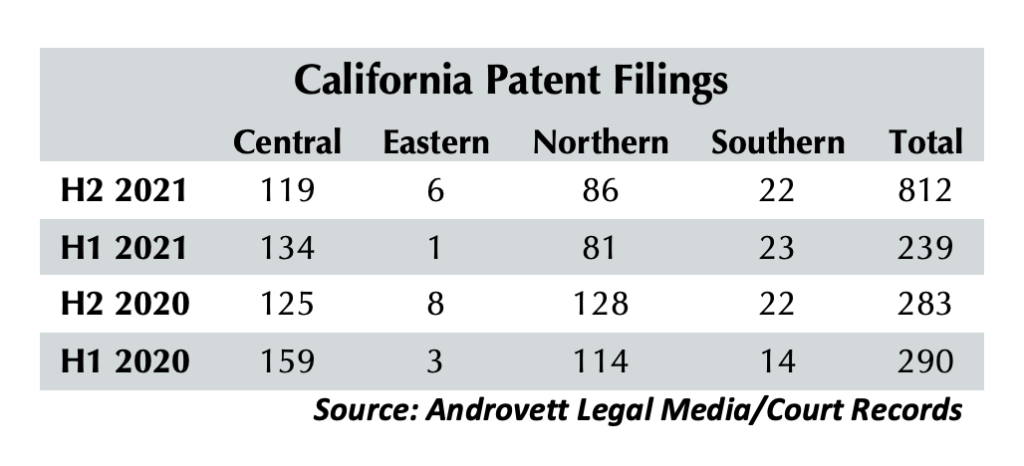Texas’ claim as the capital of the patent litigation world grew even stronger in 2021.
Despite repeated efforts by a handful of federal appellate judges and constant criticism from certain technology companies, the federal courts in the Western District of Texas and Eastern District of Texas remain two of the hottest jurisdictions in the U.S. to file patent infringement lawsuits.
The Western District – specifically the Waco Division – is home to the federal courthouse with the most patent disputes anywhere and more than the number of IP lawsuits filed in 32 other states combined.
Businesses and individuals filed 1,548 complaints alleging theft of their patented technology – an eight percent increase over 2020 and a 118 percent jump over 2019, according to data provided exclusively to The Texas Lawbook by Androvett Legal Media Research.
The data, compiled from federal court records, shows that the Western District, which includes Austin and San Antonio, saw 978 new patent infringement lawsuits lodged in 2021, which is a 12.5 percent leap from a year earlier and more than triple the number of cases from 2019.

There were 459 patent complaints filed in 2021 in the Eastern District, which includes Marshall, Plano and Beaumont, a jump of 13.6 percent from the prior year and up 55 percent from 2019.
Legal experts cite multiple reasons for the continued increase in patent infringement filings in Texas during the past year, including judges who are experienced in patent litigation, the growth of Austin as a technology growth center and an explosion in litigation funding firms seeking to invest in plaintiffs’ lawsuits.
Aimee Fagan, an IP law partner at Sidley Austin in Dallas, said one “obvious answer” is that “we live in an increasingly tech-driven society.”
“New technologies and products are introduced daily. Nearly everything depends on smart technologies,” Fagan said. “Companies compete on better technology, such that protecting one’s technology has become synonymous with protecting one’s business. Today, even smaller companies without in-house patent departments are aware of the need to protect and enforce their IP rights.”
The uptick in patent infringement cases is not confined to the technology industry.

Aimee Fagan
“We are seeing patent filings in the life-sciences space, energy, healthcare – across the board, 2022 has started off with a bang,” said Baker Botts IP partner Christa Brown-Sanford.
The Northern District, which includes Dallas and Fort Worth, and the Southern District, which includes Houston, witnessed declines in their patent dockets in 2021.

Christa Brown-Sanford
Plaintiffs lodged 61 patent infringement suits last year in the Northern District – down from 88 in 2020. The Southern District experienced a similar decline – from 72 new patent lawsuits in 2020 to 50 last year.
The 1,548 new patent infringement complaints filed in Texas last year were the most since 2016, the height of the popularity of the Eastern District prior to the U.S. Supreme Court’s decision in T.C. Heartland, which severely restricted the venues where plaintiffs could file lawsuits.
Texas’ biggest competition for patent litigation comes from Delaware and California.
The Central District of California and Northern District of California experienced significant declines in their patent dockets in 2021. The Northern District dropped from 242 patent infringement lawsuits in 2020 to 167 last year. The Central District saw its new patent caseload decline from 284 suits in 2020 to 253 in 2021.

The U.S. District Court in Delaware, however, had a 24 percent bump in new patent cases in 2021 – from 591 new infringement complaints in 2020 to 731 last year, according to Androvett data.
In Texas, the Eastern District saw a decline in new patent filings from 2017 to 2019, but then witnessed a resurgence in 2020 and another increase last year.
Patent infringement cases in the Western District were as rare as college football championships until 2018, when President Donald Trump nominated Alan Albright, a patent litigator and former federal magistrate, to the U.S. District bench. Judge Albright selected Waco, which had not had a sitting district court judge in many years, as his home court and created new lawyer-friendly rules and procedures to attract patent disputes.
It worked. In spades.
“Judge Albright has stuck to his goals of providing a fast, fair, predictable forum for patent cases,” said Arthur Gollwitzer, a partner in the Austin office of Jackson Walker. “As a former patent litigator, the judge knows patent law and knows how to keep his cases moving in a manner that is fair for all parties. He also is responsive to feedback from the lawyers who practice in his court.”
The data proves it.

There were 37 patent infringement cases filed in the Western District prior to Judge Albright taking the bench in the fall 2018. But another 51 were lodged by the end of the year. In 2019, lawyers for businesses and individuals filed 274 patent cases in the Western District. Then 869 in 2020. And then nearly 1,000 this year.
Fagan said that Judge Albright has “delivered what he promised patent litigators.”
“Of the busiest patent dockets in 2021, Judge Albright had the shortest average time to claim construction and trial, beating out Judge [James] Gilstrap in the Eastern District,” she said. “He has delivered exceptional transparency through standing orders and written procedures, as well as through numerous speaking engagements in which he has been exceptionally candid about his preferences. Like some of the Eastern District judges he practiced before earlier in his career, he also runs an efficient and controlled courtroom, which includes sanctioning misconduct where appropriate.”
There are questions about the judge’s increasingly crowded docket.
In fact, the Androvett data shows that the number of patent cases filed in the Western District declined slightly during the second half of 2021 and that new patent filings are down this January and February compared to the same two months in 2021.
“We may have reached a ceiling. That is, we may have found the maximum number of cases in a year that fit within the Western District of Texas under current venue rules,” Gollwitzer said. “On the other hand, as Austin and the rest of central Texas grow, more and more entities establish a physical presence in this district. In turn, that means if such entities are sued for patent infringement, then venue is legally proper in this district.”
There is no question that the Waco Division has been “flooded with patent cases,” Fagan said.
“Plaintiffs know there is a long list of cases to be resolved before them if they file in Judge Albright’s court,” she said. “The slight decline in new WDTX filings corresponds with a slight uptick in EDTX filings, which may reflect concerns over the volume of cases pending before Judge Albright. I expect demand for Judge Albright’s venue will ebb and flow with the volume, much like we saw in the EDTX over the years.”
Combined, the Eastern and Western districts of Texas are home to nearly two-thirds of the pending patent infringement cases being litigated in the U.S.
Editor’s note: Over the next three weeks, The Texas Lawbook will publish articles examining Judge Albright’s caseload and popularity, the efforts by a handful of judges on the U.S. Court of Appeals for the Federal Circuit to restrict venue opportunities in the Western District and the impact of litigation funding on patent disputes.
